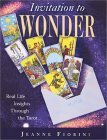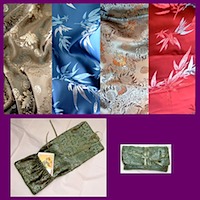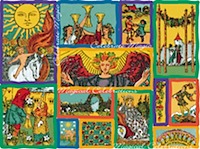By Jeanne Fiorini
I recently spent a lot of time preparing thoughts, comments, and information for an internet broadcast* and have come from that process freshly inspired about the power of Tarot.
The title of the webcast is Tarot and Quantum Physics. Don’t panic, there’s a lot in there about Tarot and only a teeny bit about physics. But the few teeny bits of physics are REALLY cool! It also is very cool when we realize that science and metaphysics now share a common language for the enigmatic and paradoxical nature of our world.
When I think of how I came to be interested in Tarot, it isn’t because I was especially psychic or gifted as a child; it was more that I had what you might call “an exaggerated sense of what is possible.” Yes, Jeanne believed in Santa until she was 12 years old. (People later in life said kindly, “Oh, how nice that you wanted to believe.” It wasn’t that, but more of an issue that, in my worldview, Santa could have existed in that way.) The science teacher said, “Humans can run up to 25 miles per hour; anything beyond that speed is a physical impossibility.” Not true, replied my innocent brain. The history teacher said that the 20th century witnessed the highest and most technologically advanced culture the world has ever seen. What a ridiculous assumption. Over and over it was painfully reinforced that most people did not share my concept of unlimited possibilities.
Fast forward 40 years: Redemption comes with quantum physics! (Except for maybe the part about Santa.) An exaggerated sense of what is possible has been recharged and refocused onto the Tarot.
It seems likely that a person with a propensity toward Tarot might also be curious about the nature of consciousness (and hence the nature of reality), and that a study of one would lead to an interest in the other. Both topics offer forays into the intuitive, the unseen, the creative and other realms laden with inconsistency. But delving into quantum physics (which in itself has become an examination of the interplay between reality and consciousness) has challenged my sense of possibilities more than the Tarot ever has.
Quantum physics is essentially, like all sciences, an attempt to define reality. And although quantum physics is by definition a science, its startling findings have blurred the line between the classical sciences and its centuries-long rival philosophy/religion/mysticism. The quantum line of inquiry has not actually defined reality, but rather redefined reality and our perceptions of what is true. It’s as if we began tuning up the car and somewhere along the line discovered that the car isn’t a car, it’s a flubbermobile. Deepak Chopra says something like, “Not only is the Universe stranger than we think it is, it is stranger than we CAN think.”
For many of us, thinking about Tarot (or considering or learning about Tarot) is as natural and easy as eating chocolate. It’s no big stretch of the imagination to embrace the wisdom of intuition, the voice of spirit guides or angels, or to speak of things which have not yet transpired.
But for those people who are spending their time in consensus reality, these experiences are quite remarkable, and in fact are considered paranormal, are fear-producing, and sound like the ravings of someone channeling Gracie Allen. But these unpredictable realities are precisely the kinds of experiences which quantum physics defines as perfectly natural aspects of the physical world.
When stated simply, the fundamental ideas behind quantum physics make a lot of sense on an intuitive level. Consider these three basic principles:
1. A fundamental truth of quantum physics is the presence, at the very base levels of matter, of a wavelike ocean of potentialities, which physicists have named the “unified field.” All matter and form arise from this undefined, nebulous net of possibilities and potentials.
2. Experiments with subatomic particles have proven that, at this level of matter, physical space and time are irrelevant. Not only can particles present themselves as either waves or particles, they also can exist in two points at the same time (called “superposition”). Quantum science has also produced evidence that not only does past experience influence the present (a fact we’ve come to expect), but that future events can also create changes in present reality. The bottom line here is that the notions of space and time are constructs of the mind invented to create form and order in the face of a chaotic universe.
3. Related to “constructs of the mind invented to create form and order in the face of a chaotic universe”… as early as 1927, physicists were learning about the importance --and impact-- of the observer in regards to any given reality. The famous Heisenberg Uncertainty Principle arose from the findings that not only does a particle (reality) change once it is observed, if/when the observer changes how they think/perceive a certain reality, that given reality changes right along with it.
This is pretty radical stuff. It’s no surprise then, eighty years later, that we find ourselves still in the chokehold of a worldview that insists upon one concrete and absolutely true reality. In that previously-accepted “clockwork universe” there is no place for creativity, or consciousness, or spirituality, or unity. And that is very comfortable place to sit for those who mistrust or disregard creativity, consciousness, spirituality, or unity.
Thankfully, as a result of the revelations of quantum physics, we all will have to learn to think differently. The dawn of the 21st century offers the opportunity for a new heaven, a new earth, and to use the already-outworn phrase, a new paradigm by which to view our world. A new reality is truly at our doorstep.
How do we apply this new way of thinking to the Tarot? Tune in for Quantum Tarot Part II next month!
*If you’re interested in hearing the internet broadcast, visit Jeanne’s website www.tarotworks.com and click the BlogTalk Radio link!


